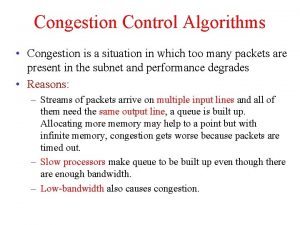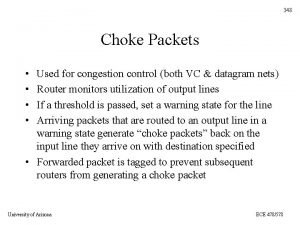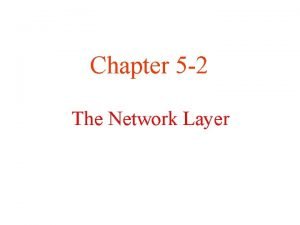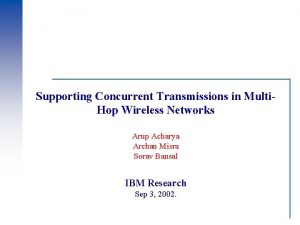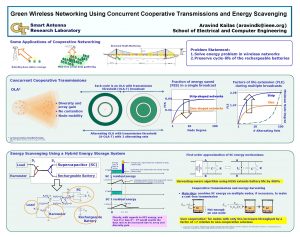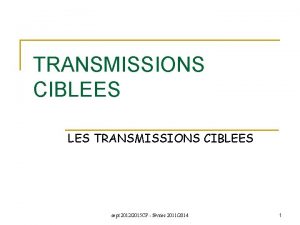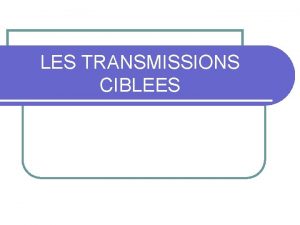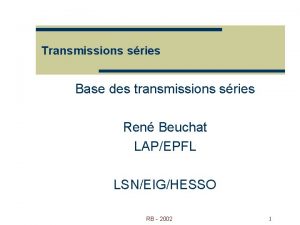Supporting Concurrent Transmissions in Multi Hop Wireless Networks












- Slides: 12

Supporting Concurrent Transmissions in Multi. Hop Wireless Networks Arup Acharya Archan Misra Sorav Bansal IBM Research Sep 3, 2002.

High Performance Multi-Hop WLANs Emergence of high-speed and variable rate WLANs. – Speeds range within (2, …, 22, 54, 108). . Mbps – Larger bit-rate smaller coverage area 54 54 Possible emergence of fixed wireless networks – Cellular-like architecture – Multi-hop wireless path to wireline gateway. 22 11 Overall Aim: Increase the transmission capacity of such networks. 2 NYMAN, Sep 3, 2002

MACA-P : Basic Aim MACA-P : Can MACA be enhanced to allow parallel transmissions? § Fundamental constraint : a recvr should not be within range of >1 transmitter P Q A B P P Q Q (1) (2) A B A B Q P (3) (4)

802. 11 Limitation on Concurrent Transmissions 802. 11 – 4 -way RTS / CTS-based exchange with no gaps. – Entire neighborhood of both sender and receiver blocked out. A B RTS data ack CTS Q B Q Key Observations – No gap between RTS/CTS and DATA/ACK phases. All phases are contiguous to one another. – Each node involved in a data packet exchange switches roles between a transmitter and a recipient. Role reversal occurs during both RTS/CTS and DATA/ACK pairs. P time

MACA-P : Increasing Concurrent Transmissions MACA-P Key idea: Let neighbors synchronize their simultaneous transmission activity. A B Q P – Preserves 802. 11 features such as exponential backoffs, DIFS, SIFS etc. Introduce variable “control” gap between RTS/CTS and DATA/ACK portions. – Neighbors use this variable gap to synchronize any feasible transmissions. – DATA/ACK portion of different transmissions are synchronized. – Following nodes (those that attempt to synchronize to an existing schedule) set inflexible bit in RTS. Tack RTS Tdata B A CTS RTS time Tdata CTS Tack Q P

MACA-P : Aligning Neighboring Data Receivers Allow a receiver to change sender’s proposed schedule if receiver has a scheduled reception in its neighborhood Q P B A – Receiver sends CTS’ (modifying schedule) Sender re-transmits RTS’ to informs neighbors of changed schedule – Also used as RTS-NACK to free channel if CTS is not received. Tack RTS Tdata P Q CTS RTS’ CTS` t 1 t 2 A B

MACA-P: Notion of Master/Slave Schedules Node initiates master transmission if it is unaware of any existing schedule. – MACA-P invoked only for large pkt sizes. Sender-receiver pair scheduling possible if at most only one member of pair has pre-existing master schedule. – Alignment with >1 masters possible but leads to severe complications. 7 NYMAN, Sep 3, 2002

Implementation Details • nav maintained as table with following entries. • Entries must be rolled back/modified on RTS’/RTS-NACK. Neighbor ID State (Tx, Rx, Idle) Tdata Tack 8 NYMAN, Sep 3, 2002

Basic MACA-P: Performance Results 9 NYMAN, Sep 3, 2002

MACA-P: Introducing Adaptive Learning MACA-P with Adaptive Learning – F(P) = F(P)*(1 -a) + O*a, Senders learn of failed parallelism and update probabilities. 10 NYMAN, Sep 3, 2002

MACA-P: Effect on Control Gap on Performance MACA-P for varying control gap in the Concentric Ring (Top: Inner Senders, Bottom: Outer Senders) 11 NYMAN, Sep 3, 2002

Conclusions MACA-P relaxes the 802. 11 constraint to increase the number of parallel transmissions. – Distributed implementation; protocol defaults to 802. 11 – Can be combined with power control/adaptive antennas etc. Outstanding Issues and Questions – Need to complete our experiments on ad-hoc topologies. We have some set-theoretic insight into the potential performance gains with MACA-P. – MAC protocols can benefit from improvements in radios/PHY layers. – Other approaches to “high performance” multi-hop wireless. Labeled-switched cut-through MAC. Flow control to avoid channel access bottlenecks. 12 NYMAN, Sep 3, 2002
 Hop to hop
Hop to hop Hop by hop choke packet
Hop by hop choke packet Hop on hop off delhi
Hop on hop off delhi Hop by hop choke packet
Hop by hop choke packet Old school hip hop trivia
Old school hip hop trivia Choke packet in computer network
Choke packet in computer network Hop by hop choke packet
Hop by hop choke packet Hip hop merkmale
Hip hop merkmale Hip hippity hop
Hip hippity hop Telecommunications, the internet, and wireless technology
Telecommunications, the internet, and wireless technology Geoves butterfly wireless multi sensor
Geoves butterfly wireless multi sensor Local wireless networks
Local wireless networks Wired media and wireless media
Wired media and wireless media



